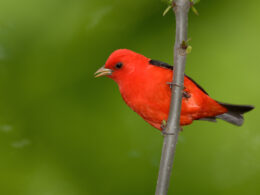Last Updated on January 20, 2024 by Greg Gillson
Did you see a brightly colored red bird, orange bird, or yellow bird in Idaho and wonder what it was?
This page is for you!
This article shows you photos and identification of some of the most common birds in Idaho based on color.
The list of birds found in Idaho includes over 435 species. So, I can’t show you all of them. I’m going to assume that you saw a common bird of this color, but you certainly could have seen something less common, or even rare!
Shape (including the shape of the bill) and size are often more helpful in starting to identify a bird than the color. In fact, most birds in North American can be easily identified with a black-and-white photo!
Many birds are multi-colored, so that it may be hard to pick out a dominant color. Males and females may be colored quite differently. And some color patterns are similar among otherwise dissimilar species.
Nevertheless, I’m going to try to pick out some of the birds that you are most likely to see in backyards or towns. And I’ll show a few others that I get asked about a lot.
The birds with a noticeable amount of red on them in Idaho covered in this article are:
- American Robin
- House Finch
- Cassin’s Finch
- Red Crossbill
The birds with a noticeable amount of orange on them in Idaho covered in this article are:
- Northern Flicker
- American Kestrel
- Red-breasted Nuthatch
- Barn Swallow
- Spotted Towhee
- Bullock’s Oriole
- Black-headed Grosbeak
- Ruddy Duck
- Cinnamon Teal
- Cooper’s Hawk
- Rufous Hummingbird
The birds with a noticeable amount of yellow on them, including lots of yellow and black birds, in Idaho covered in this article are:
- American Goldfinch
- Lesser Goldfinch
- Pine Siskin
- Yellow-rumped Warbler
- Western Meadowlark
- Yellow Warbler
- Cedar Waxwing
- Western Tanager
- Western Kingbird
- Yellow-headed Blackbird
- Common Yellowthroat
- MacGillivray’s Warbler
- Yellow-breasted Chat
Red birds of Idaho
Birds get the red, orange, and yellow in their feathers from carotenoids in the fruit, seeds, and plants they eat (source).
These carotenoid colors combine with melanin to form an infinite range of red feathers–pink, rusty, scarlet, violet, red-orange.
The following are red birds that you are most likely to see in Idaho.
American Robin
These are familiar lawn birds with red breasts.
 |
| American Robin. Greg Gillson. |
Male American Robins are brownish-gray above with a brick red breast. Females are paler orange below and paler gray above.
They are widespread in open country with scattered deciduous trees, residential areas.
American Robins are year-round residents throughout Idaho.
House Finch
When people ask about a bird with a red head at their feeder, it is usually this bird.
 |
| Male House Finch. Greg Gillson. |
Males of this dusty brown striped finch have red limited to the head (specifically the forehead and eyebrow), breast (chest), and rump. The red coloration tends toward orangish, and may rarely be yellowish.
Females are streaked, similar to the males but without red. They lack any strong pattern on the face and head.
Note the small round head and curved upper ridge on the bill.
Some people call these red-headed sparrows. Sparrows and finches are similar, but in general, male finches are brighter than the females and tend to hang out more in trees. Sparrow genders are usually quite similar in coloration and tend to feed mostly on the ground.
These birds are common in residential areas, especially at bird feeders. In the West more widespread in arid regions near water.
House Finches are year-round residents in lowlands of southern and southwestern Idaho.
Cassin’s Finch
These red finches are found in ponderosa pine.
 |
| Cassin’s Finch. Greg Gillson. |
Males of these brownish finches are frosted with pink on the upper parts. The crown is the brightest red. They are not streaked on the under parts.
Females lack the red. They have a pale outline of the darker ear patch. Like the males, females are shaped with a large bill that is straight on the upper ridge. The tail is strongly forked.
These finches are found in dry mountain forests of ponderosa pine and juniper. Similar Purple Finches are found in deciduous and wet conifers. House Finches are found in towns everywhere.
Cassin’s Finches will visit feeders within pine forests.
Cassin’s Finches are year-round residents throughout Idaho.
Red Crossbill
These red finches use their uniquely crossed bills to pry seeds from cones.
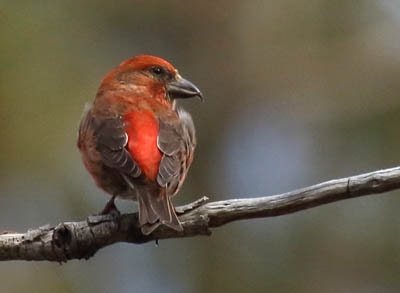 |
| Red Crossbill. Greg Gillson. |
Males are deep red with blackish wings and forked tail.
Females more yellowish-green.
Always found in conifers, frequently in the mountains. Much variation in bill size. Smaller-billed populations feed on small spruce and fir cones. Larger-billed populations feed on large hard pine cones.
Red Crossbills are year-round residents throughout Idaho
Orange birds of Idaho
True orange-colored birds are not that common. Many birds that I have here are paler rusty.
The common pattern is an orange body and black or brown wings and tail. Another common pattern is for the orange to be restricted to the under parts.
The following are orange birds that you are most likely to see in Idaho.
Northern Flicker
These unusual woodpeckers with orange under wings are just as likely to be found hopping on your lawn eating ants as they are to be calling from a dead treetop.
 |
| Northern Flicker. Greg Gillson. |
Where is the orange color?
Wait for it…
 |
| Northern Flicker. Greg Gillson. |
The shafts and undersides of the wing and tail feathers are a salmon orange color. A large white rump patch also attracts attention as these birds fly away.
Northern Flickers live in open woods, residential areas. Sometimes visit feeders in winter.
Northern Flickers are year-round residents throughout Idaho.
American Kestrel
These are the familiar small rusty-orange falcons sitting on power lines on the edge of the highway or hunting and hovering over the median strip.
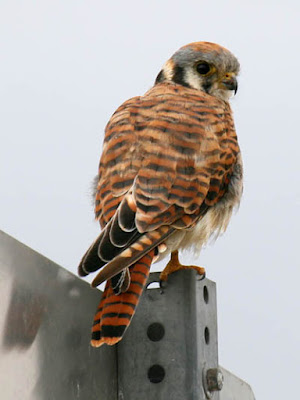 |
| Female American Kestrel. Greg Gillson. |
Females are rusty orange barred with black on their back wings and tail. The under parts are buff with black spots. The head shows two facial stripes.
Males have blue-gray backs and rufous tail is unmarked except for black tail band.
These birds are found in open country, farms, pastures with perches.
American Kestrels are year-round residents throughout most of Idaho but summer residents only in far eastern Idaho.
Red-breasted Nuthatch
These active little red-breasted birds crawls all around on the trunk and big branches of conifers. They search crevices in the bark for insect food.
 |
| Red-breasted Nuthatch. Greg Gillson. |
These tiny birds have blue-gray backs and a black line through a white face. Some males can have quite bright rusty red under parts. Some females can have quite pale buff-colored under parts. Most birds show an orange-cinnamon breast color.
Found nearly exclusively in conifers. Readily come to feeders.
Red-breasted Nuthatches are year-round residents throughout Idaho.
Barn Swallow
These orange-bellied birds are a familiar sight across North America in summer.
 |
| Barn Swallow. Greg Gillson. |
These birds are purple-blue above with orange under parts and long forked tails. The color of the underparts in winter or on females are often cinnamon or buff-colored, but breeding males can be brighter orange-red.
These birds swoop low over fields and wetlands at lower elevations. They may build their mud nests in rafters on porches, garages, or other out-buildings.
Barn Swallows are summer residents throughout Idaho.
Spotted Towhee
These big sparrows with red sides superficially resemble the coloration of robins.
 |
| Spotted Towhee. Greg Gillson. |
These birds have dark hoods and upper parts with rusty rufous-red sides and white bellies. They have white spots over their wings, shoulders, and on their tail corners. The upper parts of the males are jet black, females dark brown. Some populations have paler orange sides.
These are somewhat shy birds that hide in the dense brush and spend most of their time on the ground. They visit feeders during quiet periods.
Spotted Towhees are summer residents across much of Idaho but year-round residents in southwestern Idaho.
Bullock’s Oriole
These bright orange and black birds are often seen in tall trees.
 |
| Male Bullock’s Oriole. Greg Gillson. |
The males of this species are very bright orange. The back and top of the heads are black. The black wings have large white wing patches. The tail is black with orange sides. The face is orange with a black line through the eye and a black throat.
Females and young are gray with yellow head and breast and tail.
These birds are more common in drier inland regions along watercourses in tall cottonwoods or shade trees. Rarely come to feeders for fruit or nectar in spring.
Bullock’s Orioles are summer residents across southern Idaho and along the western border of Idaho.
Black-headed Grosbeak
If you didn’t look closely at these big-billed birds, you might mistake these orange-breasted songsters for American Robins–their coloration and song are very similar!
 |
| Male Black-headed Grosbeak. Greg Gillson. |
Males have black and white wings and tail. Huge bill. The under parts are burnt orange, fading to yellow-orange mid-belly.
Females and first year birds have a striped heads and are brown above, pale buff or butterscotch-orange below.
These birds are found in deciduous or mixed woods. Visit bird feeders.
Black-headed Grosbeaks are summer residents throughout Idaho.
Ruddy Duck
These small ducks are dark rusty-orange in spring.
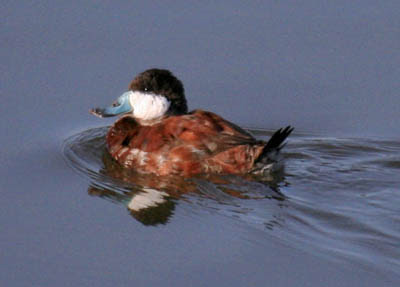 |
| Ruddy Duck. Greg Gillson. |
Males in breeding plumage (late winter and spring) are rusty, with a white face, and a blue bill. The long tail is often held sticking up. In winter they are brown, with white face, and dark bill.
Females all year are like winter males. Brown body, dark cap, dark line through eye of pale face. Dark bill.
These birds prefer weedy ponds to breed, but in winter may be found in deeper ponds in city parks.
Ruddy Ducks are summer residents across southern Idaho and year-round residents in southwestern Idaho.
Cinnamon Teal
What an unusually colored brownish-orange duck!
 |
| Male Cinnamon Teal. Greg Gillson. |
Males are dark cinnamon orange. The wing patches are blue, green, and white. The eye is red.
Females are more mottled brown with matching wing patches.
These birds are found in ponds and grass-lined ditches.
Cinnamon Teals are summer residents throughout Idaho.
Cooper’s Hawk
These crow-sized hawks with reddish orange bars on the under parts may show up in fall or winter to hunt birds at your feeder. Oh no!
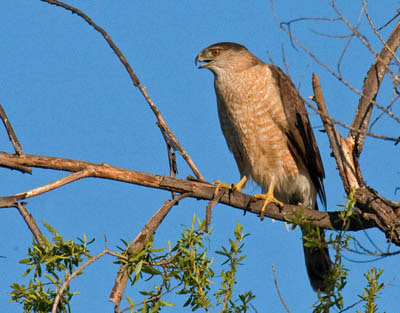 |
| Cooper’s Hawk. Greg Gillson. |
Adults with long gray and black banded tail. Dark gray above and cap on head. Under parts barred with rusty orange.
Immatures similar, brownish, streaked with brown on under parts.
Found in forests and woodlands, residential shade trees.
Cooper’s Hawks are year-round residents in most of Idaho, summer residents only in northern Idaho.
Rufous Hummingbird
These are the common widespread hummingbirds of the Pacific Northwest and Alaska. These orange birds don’t like to share the hummingbird feeder–frequent chases are the norm.
 |
| Rufous Hummingbird. Greg Gillson. |
Males are all-over rusty orange, tending to pinker cinnamon on the under parts. Even the back and rump and base of the tail feathers are orange. Males have a bright red throat gorget when the sunlight catches it just right.
Females are green above, with a small green or red spot in the center of the white throat. Flanks and sides cinnamon. Tail base orange.
These birds are found in forest edges, yards, in all but the highest mountains.
Rufous Hummingbirds are summer residents in most of central, western, and northern Idaho, spring and fall migrants only in southeastern Idaho.
Yellow birds of Idaho
Yellow is a common bird color! Often it is mixed with black and white plumage in birds.
Many birds with darker upper parts have yellow breast or belly.
The following are yellow birds you are most likely to see in Idaho.
American Goldfinch
These small little birds are bright yellow and black.
 |
| American Goldfinch. Greg Gillson. |
Males are bright lemon yellow with black and white wings and tail, black cap. White under tail coverts. Pink bill.
Females are duller yellow below and brownish above. Lack black cap.
Winter birds are pale brown or gray, a touch of yellow on the throat of males.
These are birds of open country, fields with saplings, clear cuts, residential areas. They avoid dense forests, mountains, deserts. They visit feeders.
American Goldfinches are year-round residents throughout Idaho.
Lesser Goldfinch
Lesser Goldfinches maintain their bright yellow plumage all year–even in the winter when American Goldfinches are rather brown and colorless.
 |
| Male Lesser Goldfinch. Greg Gillson. |
These tiny birds are bright yellow below (including under the tail), and green or black on the back. The wings and tail are black and white. Males have a black cap, which the females lack.
These birds are found near water in arid regions of the West and Southwest. They are common in residential areas, too, and come to bird feeders.
Lesser Goldfinches are summer residents in south-central Idaho.
Pine Siskin
These small brown-streaked birds are relatives of the goldfinches. But you would never know it until they fly and sport yellow wing stripes and tail base. Usually in flocks.
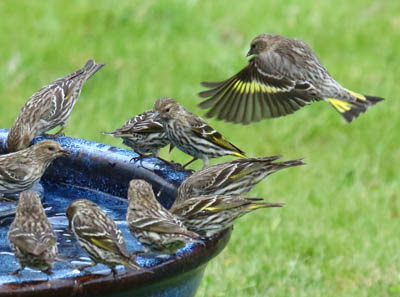 |
| Pine Siskin. Greg Gillson. |
These birds are streaked brown. In flight they have a yellow stripe down the length of the wing. The sides of the base of the tail are also yellow. Some birds are paler, some darker, others brighter yellow, others duller.
These birds are found in summer in northern conifer woods. Irregularly irrupt hundreds of miles southward. Frequent at feeders.
Pine Siskins are year-round residents throughout most of Idaho but winter visitors only to extreme southwestern Idaho.
Yellow-rumped Warbler
These are abundant warblers across North America. Affectionately called “butter butts” by many birders, because of their bright yellow rumps that flash in flight.
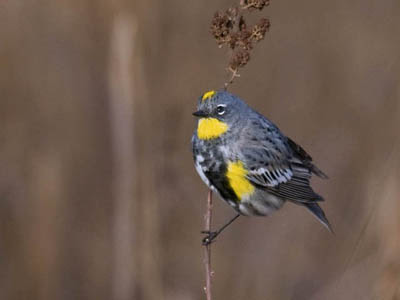 |
| Male Audubon’s Yellow-rumped Warbler. Greg Gillson. |
Western form (Audubon’s) with bright yellow throat and yellow rump. Large white wing patch.
Northern and Eastern form (Myrtle) with white throat, yellow rump, and two white wing bars.
Winter birds are dull gray brown, with bright yellow rump. Throat may be cream colored or white. Often difficult to tell the two forms apart in winter.
 |
| Winter Yellow-rumped Warbler. Greg Gillson. |
Breed in mountain or boreal conifers. Widespread in migration. Winter in low river bottoms, open weedy deciduous areas. Rarely come to feeders in winter.
Yellow-rumped Warblers are summer residents in northern and eastern Idaho, spring and fall migrants only in central and southwestern Idaho.
Western Meadowlark
These are streaky camouflaged prairie birds from above or from behind. But from the front, the breast is shocking yellow!
 |
| Western Meadowlark. Greg Gillson. |
They are streaked brown, black, and gray on the upper parts. The underparts are golden yellow with a black necklace crossing the upper breast. Much paler yellow in fall and winter, as the yellow feathers are tipped with white and streaked with brown.
These are birds of pastures and grasslands and arid regions.
Western Meadowlarks are summer residents throughout Idaho and year-round residents in extreme southwestern Idaho.
Yellow Warbler
The golden yellow sun packed all into one little bird! Appears to be an all-yellow bird.
 |
| Yellow Warbler. Greg Gillson. |
Some populations are bright yellow, some tend toward greenish on upper parts, some more golden. Yellow internal tail corners in flight.
Males with red breast streaking, again, variable by population.
Females somewhat to much paler yellow, some greenish, some whitish. Lack red streaks.
These birds are found in willow thickets on the edge of wetlands and ditches, stream sides in arid regions.
Yellow Warblers are summer residents throughout Idaho.
Cedar Waxwing
These crested birds with yellow band on the end of the tail are often found in flocks. They eat flying insects in summer, fruit and berries the rest of the year.

These birds are fawn-brown above, with dark gray wings and tail. They have a black mask and wispy crest. The belly is yellow. The wings have waxy red drops on the end of the tertials. The end of the tail has a brilliant yellow tail band.
They are found in open habitats with berries, including juniper woodlands and towns in winter.
Cedar Waxwings are year-round residents throughout Idaho.
Western Tanager
Numbers of these bright black and yellow birds may show up overnight in backyards in spring migration. Then they disappear the next night.
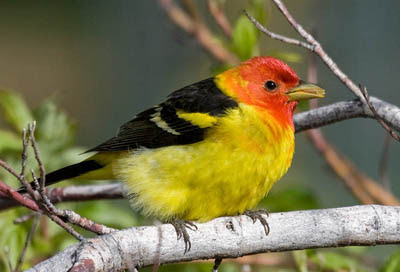 |
| Western Tanager. Greg Gillson. |
Males are brilliant golden yellow with black back, wings, and tail, and a red or orange face. Swollen yellow bill.
Females are more green or gray, with darker wings and tail. Lack red face.
They are found in a variety of wooded habitats, usually conifers or mixed conifer woods, and residential areas with large trees, including mature conifers. Usually don’t visit feeders.
Western Tanagers are summer residents throughout Idaho.
Western Kingbird
These yellow-bellied birds of the prairies often perch on power lines and fence lines.
 |
| Western Kingbird. Greg Gillson. |
These birds are pale gray on the head and breast. Brown wings. The belly is lemon yellow. Black tail has white outer tail feathers, especially obvious in flight.
These are birds of prairies, deserts, pastures, often near water.
Western Kingbirds are summer residents throughout Idaho.
Yellow-headed Blackbird
These blackbirds with yellow heads are found in marshes in the West.
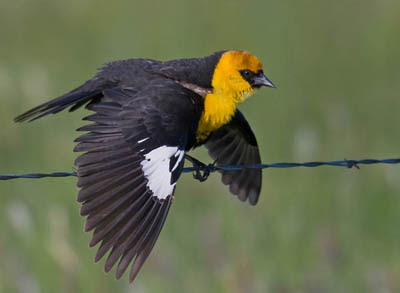 |
| Yellow-headed Blackbird. Greg Gillson. |
Males are glossy black with bright golden-yellow head and breast. White wing patches.
Females are duller brown with mottled yellow breast.
These birds nest in cattail marshes in prairies. Winter in large flocks in agricultural areas.
Yellow-headed Blackbirds are summer residents throughout Idaho.
Common Yellowthroat
These buttery yellow birds are abundant in the marsh vegetation.
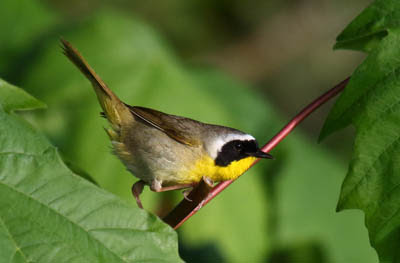 |
| Male Common Yellowthroat. Greg Gillson. |
These skulkers have bright yellow throats and yellow undertail coverts. Males have a black domino mask edged broadly in white, which females lack. Upperparts are dull olive-green.
Immature males in fall show a shadowed black mask.
Found in damp situations and heavy deciduous brambles following clear cuts.
Common Yellowthroats are summer residents throughout most of Idaho, absent where there is no water.
MacGillivray’s Warbler
These are yellow-bellied birds of brushy clear cuts.
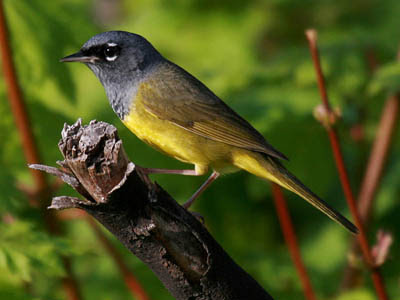 |
| MacGillivray’s Warbler. Greg Gillson. |
These ground-loving birds have gray hoods with white eye arcs. Rest of upper parts green. Breast, belly, under tail bright yellow.
Females have slightly paler gray hood but are otherwise similar to males.
These birds love brushy clear cuts, tangles, thick cover. They stay low.
MacGillivray’s Warblers are summer residents in northern and eastern Idaho, absent in central and southwestern Idaho.
Yellow-breasted Chat
These unique larger yellow birds may sing day and night, and include whistles and crow-like cawing, often given in a display flight.
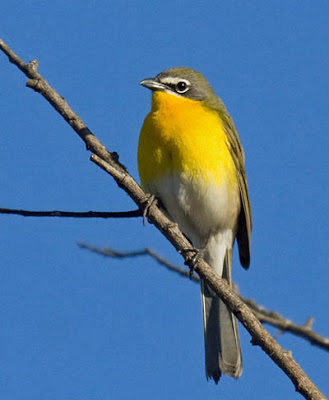 |
| Yellow-breasted Chat. Greg Gillson. |
These birds are greenish above with bright yellow breast and white belly. They have a dark mask bordered with white.
These birds live in tangles and wet woods.
Yellow-breasted Chats are summer residents throughout Idaho.
Wrapping Up
So there is my list of red, orange and yellow birds in Idaho. But the state has many more colorful birds to offer. Here are a few more to whet your appetite.
Western Bluebird: These charming residents sport bright blue upperparts, rusty chests, and white bellies, filling the air with their sweet, whistled songs. Look for them in open woodlands, meadows, and around farms.
Mountain Bluebird: Similar to their Western cousins but slightly smaller, these high-altitude residents frequent open coniferous forests and meadows, particularly in the mountains. Their calls are a bit higher-pitched and more trilling.
Clark’s Nutcracker: These large, crow-sized birds boast a stunning turquoise and blue plumage, accented with black wings and white wingbars. Look for them in high mountain forests, where they crack open pine nuts with their powerful beaks.
Blue-gray Gnatcatcher: These tiny acrobats dart through trees and shrubs, their blue-gray upperparts and white underparts blending with the foliage. Listen for their thin, high-pitched “zeet” calls.
Warbling Vireo: These olive-green songbirds with white wingbars serenade the woods with their complex, warbling melodies, often from high treetops.
Frequently Asked Questions
What kind of bird is red headed in Idaho?
The House Finch is probably what you are seeing. It’s a year-round resident and can be expected in most parts of the state.
Here are some facts about House Finches:
- Habitat: They thrive in human-created environments, so you’ll find them in cities, towns, suburbs, and even rural areas with houses and farms. They love backyards, parks, gardens, and open areas with trees and shrubs.
- Appearance: Males have a red breast and head, with streaks on their sides and a brown back. Females are brownish-gray with streaking and lack the bright red.
- Song: Both males and females sing, with males having a more complex and varied song. Their characteristic call is a high-pitched “tweet.”
- Diet: They primarily eat seeds, grains, and berries. You can attract them to your feeders with black oil sunflower seeds, safflower, and hulled sunflower seeds.
- Breeding: They breed from April to August, building nests in trees, shrubs, and even on buildings. They can have multiple broods in a season.
What is the bright orange bird in Idaho?
You are hopefully looking at the Bullock’s Oriole, a really interesting bird. While they are not common in Idaho, they are occasionally spotted in certain parts of the state, especially during spring and fall migration. Here are some areas where you might have the best chance of finding them:
1. Southwest Idaho:
- Boise River Greenbelt: A long, tree-lined corridor that attracts migrating birds.
- Lucky Peak State Park: Offers a mix of habitats, including cottonwood trees along the Boise River, which are favored by Bullock’s Orioles.
- Birds of Prey National Conservation Area: Known for its raptors, but also hosts migrating songbirds, including Bullock’s Orioles in riparian areas.
2. Southern Idaho:
- Snake River Canyon: The cottonwood and willow trees along the Snake River provide potential habitat.
- Bruneau Dunes State Park: The park’s cottonwood groves and riparian areas along the Bruneau River may attract migrating Bullock’s Orioles.
3. Eastern Idaho:
- Henry’s Fork of the Snake River: The cottonwood trees along the river corridor offer potential habitat.
- Camas National Wildlife Refuge: While primarily known for waterfowl, the refuge’s riparian areas may also attract Bullock’s Orioles during migration.
What are the yellow orange birds in Idaho?
The vibrant red plumage of male Western Tanagers, particularly their heads, boasts a fascinating story intertwined with diet, environment, and even social signaling. Here are some key reasons why these tanagers sport such bright colors:
Diet: Unlike most red birds, whose redness comes from carotenoids in plants, the red head of a Western Tanager comes from a unique pigment called rhodoxanthin. This pigment is found in insects like conifer aphids and leafhoppers, which the tanagers consume. As they eat these insects, the rhodoxanthin gets incorporated into their feathers during feather growth, creating the stunning red hue.

Environment: Coniferous forests, the primary habitat of Western Tanagers, offer ample access to insects rich in rhodoxanthin. This specific adaptation to their environment allows them to reliably acquire and display this vibrant color.
Social Signaling: The male Western Tanager’s red head plays a crucial role in attracting mates and asserting dominance. The brighter the red, the more attractive and healthier the male is perceived, giving him an edge in breeding competition. Additionally, the red plumage serves as a visual signal to both mates and rivals, conveying important information about territory and hierarchy within the flock.
Camouflage: While the male’s head stands out, the rest of their plumage, consisting of olive-green upperparts and yellow underparts, provides some camouflage during foraging and nesting in forested areas. This allows them to blend in with the foliage while searching for food or protecting their young.
Evolutionary Benefits: The combination of diet-derived pigment, suitable environment, and social signaling benefits has likely driven the evolution of the Western Tanager’s distinct red coloration. This specific adaptation enhances their reproductive success and survival in their coniferous forest habitat.
Related Articles:
Most common backyard birds in Idaho
Birds with red heads in North America.
Yellow-and-black birds in North America.
Little Brown Birds at your Feeder.










